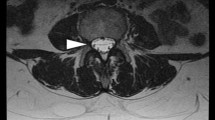Abstract
Purpose
To describe the successful management of priapism secondary to sickle cell anemia in a child using neuraxial analgesia provided via an epidural catheter.
Clinical features
A seven-year-old male presented with chest crisis and priapism which, following hemoglobin electrophoresis led to a new diagnosis of sickle cell anemia. Epidural management was attempted as an alternative to surgery after failure of more conventional medical and surgical methods to treat the priapism. The patient’s clinical condition improved with this intervention and together with further conservative therapy resulted in complete resolution of the priapism.
Conclusions
Priapism is a well described complication of sickle cell anemia that is painful and difficult to manage. Surgical intervention is the last therapeutic resort and often results in significant long-term morbidity. This case highlights how select cases of priapism can be successfully managed with epidural neuraxial blockade which not only provides superior analgesia for the often painful conservative treatments, but may also per se impart a direct and salutary therapeutic benefit.
Résumé
Objectif
Décrire la prise en charge réussie du priapisme secondaire à l’anémie falciforme chez un enfant à l’aide d’une analgésie neuraxiale administrée par un cathéter péridural.
Éléments cliniques
Un garçon de sept ans s’est présenté avec une douleur à la poitrine et un priapisme; à la suite d’une électrophorèse de l’hémoglobine, une anémie falciforme de novo a été diagnostiquée. Nous avons utilisé la péridurale comme alternative à la chirurgie après l’échec des méthodes médicales et chirurgicales plus conventionnelles dans le traitement du priapisme. L’état clinique du patient s’est amélioré grâce à cette intervention et, combinée à une thérapie conservatrice, cette méthode a eu pour résultat de résoudre complètement le priapisme.
Conclusion
Le priapisme est une complication bien décrite de l’anémie falciforme dont la prise en charge est difficile et douloureuse. L’intervention chirurgicale est le dernier recours thérapeutique et a fréquemment pour résultat une morbidité significative à long terme. Ce cas met en évidence que certains cas particuliers de priapisme peuvent être pris en charge de manière réussie avec un bloc neuraxial péridural, lequel non seulement fournit une meilleure analgésie pour les traitements conservateurs souvent douloureux, mais peut aussi, en soi, offrir un bienfait thérapeutique salutaire.
Similar content being viewed by others
References
Corke PJ, Watters GR. Treatment of priapism with epidural anaesthesia. Anaesth Intensive Care 1993; 21:882–4.
Labat F, Dubousset AM, Baujard C, Wasier AP, Benhamou D, Cucchiaro G. Epidural analgesia in a child with sickle cell disease complicated by acute abdominal pain and priapism. Br J Anaesth 2001; 87:935–6.
Pelavski AD, Suescun MC, Conesa A, Aranda M. Priapism in an infant caused by post-operative analgesia through epidural catheter. Acta Anaesthesiol Scand 2006; 50:632.
Vazquez Perez MJ, Sanchez del Mazo MT, Pose Cambeiro MP, Fraga Garcia M. Prolonged priapism after locoregional anesthesia (Spanish). Rev Esp Anestesiol Reanim 1988; 35:157–8.
Keoghane SR, Sullivan ME, Miller MA. The aetiology, pathogenesis and management of priapism. BJU Int 2002; 90:149–54.
Kulmala R, Lehtonen T, Nieminen P, Tammala T. Aetiology of priapism in 207 patients. Eur Urol 1995; 28:241–5.
Pohl J, Pott B, Kleinhans G. Priapism: a three-phase concept of management according to aetiology and prognosis. Br J Urol 1986; 58:113–8.
Maples BL, Hagemann TM. Treatment of priapism in pediatric patients with sickle cell disease. Am J Health Syst Pharm 2004; 61:355–63.
Mantadakis E, Cavender JD, Rogers ZR, Ewalt DH, Buchanan GR. Prevalence of priapism in children and adolescents with sickle cell anemia. J Pediatr Hematol Oncol 1999; 21:518–22.
Montague DR, Jarow J, Broderick GA, et al. American Urological Association guideline on the management of priapism. J Urol 2003; 170(4 Pt 1):1318–24.
Rao TH, Zaman W, Jain RK. Intraoperative penile erection. Arch Esp Urol 2000; 53:953–6.
Sengezer M, Deveci M, Ozturk S, Bozkurt M, Kurt E, Suer AH. Two in one: patient-controlled epidural analgesia (PCEA) to prevent erection and control pain in adult hypospadias-surgery patients. Br J Plast Surg 2002; 55:494–7.
Booke M, Waurick R, Van Aken H, et al. Effects of sympathetic nerve blockade on vasoconstrictive properties of nitric oxide synthase inhibition in sheep. Cardiovasc Res 1997; 36:111–7.
Ai K, Kotake Y, Satoh T, Serita R, TakedaJ, Morisaki H. Epidural anesthesia retards intestinal acidosis and reduces portal vein endotoxin concentrations during progressive hypoxia in rabbits. Anesthesiology 2001; 94:263–9.
Author information
Authors and Affiliations
Corresponding author
Additional information
The authors have no disclaimers to declare or conflicts of interest relating to this article.
Rights and permissions
About this article
Cite this article
McHardy, P., McDonnell, C., Lorenzo, A.J. et al. Management of priapism in a child with sickle cell anemia; successful outcome using epidural analgesia. Can J Anesth 54, 642–645 (2007). https://doi.org/10.1007/BF03022958
Accepted:
Published:
Issue Date:
DOI: https://doi.org/10.1007/BF03022958




